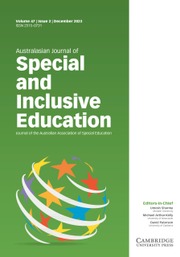Article contents
Brief Report: A Pilot Study Into the Efficacy of a Brief Intervention to Teach Original Fictional Narratives to a Child With ASD and Language Disorder
Published online by Cambridge University Press: 30 July 2019
Abstract
The ability to generate narratives is important for literacy development. Children with autism spectrum disorder (ASD) have been found to generate less complex narratives than typically developing peers. This pilot AB study was designed to investigate the efficacy of a brief intervention procedure to develop the macrostructure of original fictional narratives based on a realistic scenario in one child, aged 9 years 8 months, with autism spectrum disorder and language disorder. The intervention targeted the characters, setting, problem, feelings, and fix of fictional narrative. Intervention involved the use of macrostructure icons, pictures to support the generation of narratives, clinician modelling, and the participant telling the entire narrative each session. The participant received 12 training sessions of 4–6 minutes each and the intervention was effective. Areas for future research include implementation of a stronger research design and investigation of generalisation to fantasy-based fictional narratives.
- Type
- Special Education Perspectives
- Information
- Australasian Journal of Special and Inclusive Education , Volume 43 , Issue 2 , December 2019 , pp. 102 - 108
- Copyright
- © The Author(s) 2019
Footnotes
This manuscript was accepted under the Editorship of David Paterson.
References
- 1
- Cited by


